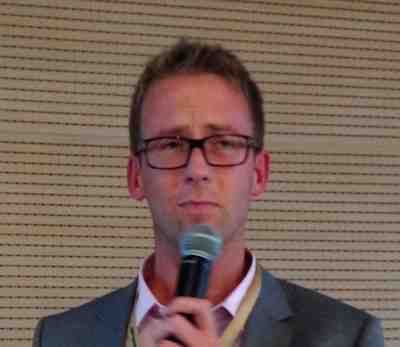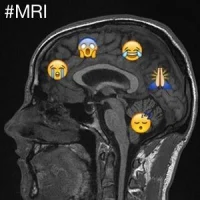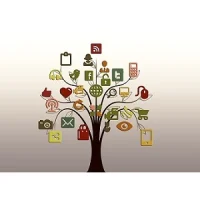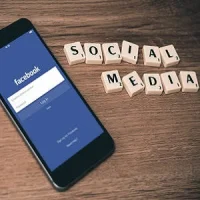The irony of being without wifi while talking about social media was not lost on delegates to the Management in Radiology (MIR) Annual Scientific Meeting in Bologna this month. However, the temporary glitch did not detract from an informative session on the dos, don’ts and possibilities of social media.
Social media brings visibility and exchange to radiologists, both with patients and colleagues, said Pablo Rodríguez from Spain. Reputation and privacy are at stake, and it is necessary to separate work and private life, whilst being honest and transparent. Social media accounts need to be up-to-date - refresh the content, and get input from patients and colleagues.
Lorenzo Faggioni, from Italy, recommended several resources for the radiologists looking to get more out of professional education and communication. He cited a blog post by Cathy Garzio from UCSF about making radiologists more visible through social media, while Sumer Sethi has blogged about Facebook for diagnostic centres. Radiologists can benefit from professional social networking websites by efficiently building, developing and maintaining a professional network, discover new business, career or research or business opportunities.
Radiologists using social media need to consider confidentiality (who is the owner of the images - patient, institution, science?) and achieve consensus on educational/scientific non-profit activities. Images and data need to be anonymous to avoid exposure of either patient or professional.
Institutions need to own their social media, said Peter Pokieser, from Austria, who spoke about the Medical University of Vienna’s use of social media in blended learning. In his view, institutional social media, controlled by responsible staff, rules and administration relies more on standards, is less flexible, but more sustainable. At his university, WebAmbulanceEmergency presents interdisciplinary emergency cases to 500 students weekly using blended learning, peer-assisted classical Web 2.0 design. Preparation starts 1 week before and takes about 90 minutes, but the course has been well-received.
 Jon Bell, from the UK talked about the pros and cons of social media, Twitter in particular. With more than 500 million uses and over 1.6 billion searches a day it cannot be ignored. As a medium it enables the health professional to be locally responsive but globally connected - the recommendation of the Lancet article on health professionals for a new century. It can be used for engagement, networking, crowdsourcing, providing and sharing information and to start offline discussions. Bell cited the example of the NHS Change Day on 31 March 2014, when around 200,000 tweets were made as pledges to improve patient care.
Jon Bell, from the UK talked about the pros and cons of social media, Twitter in particular. With more than 500 million uses and over 1.6 billion searches a day it cannot be ignored. As a medium it enables the health professional to be locally responsive but globally connected - the recommendation of the Lancet article on health professionals for a new century. It can be used for engagement, networking, crowdsourcing, providing and sharing information and to start offline discussions. Bell cited the example of the NHS Change Day on 31 March 2014, when around 200,000 tweets were made as pledges to improve patient care.
Tweeters should be aware of the risks of privacy and confidentiality in the patient-doctor relationship. Studies on doctors’ use of Twitter have found some that breach common guidelines, e.g. Brynoff writing in BMJ Open and Chretien writing in JAMA.
In the UK the Medical Defence Union has seen a 40% increase in enquiries about social media. These include queries about complaints made by patients about doctors on social networking sites, friednship requests from patients and difficulties after posting comments and images.
Think before you tweet, said Bell. Use for education, behave professionally online, appropriately and responsible, and follow professional standards. Bell agreed there were benefits - in engaging people in public health and policy discussions, establishing national and international professional networks, and facilitating patients’ access to information about health and services.
Various advice exists for doctors, including from the Royal College of General Practitioners' Social Media Highway Code, the General Medical Council and the British Medical Association. The General Medical Council advised doctors to identify themselves by name when posting as a doctor on publicly accessible social media:
However, this advice caused some controversy, especially in the context of whistleblowing, with some commentators seeing it as preventing freedom of speech and breaching human rights and silencing doctors so that the public will no longer hear their views about what is happening. In response the GMC stated that “no-one is going to be struck off for failing to reveal their identity.” The advice is to use appropriate channels to raise concerns rather than social media - i.e. local procedures, via the regulator. Concerns should only be made public if these options have been tried and you still believe patients are at risk.
One GP surgery asked its patients to complaint to the practice manager, thus ensuring confidentiality rather than post negative comments on Facebook and Twitter.
GMC advice states, "Don'’t blur professional boundaries, and check privacy settings. A ‘friend’ request on Facebook is outside the boundaries of your professional relationship. You should indicate that you cannot mix social and professional relationships and, where appropriate, direct them to your professional profile. "
Even if your Twitter account has only a few followers, it can still be public and counted as such. A civil servant in the UK, who tweeted about her hangovers, did not have her complaint to the press complaints commission upheld.
Bell concluded that old principles still apply in the new practice of social media. Do not tweet anything that you would not want your boss or kids to see.
———————————
Websites (Cited by Dr. Rodríguez)
Online journal clubs
ACR
SERAM
Cloud-based PACS
Osirix
Purview
OnePacs
Medical Social Networking
Doximity
Ozmosis
Doc2doc
esanum
Sermo®
Realtime Clinical Communities
Careflow
DocbookMD®
Airstrip®
Radiology Communities
RadRounds
Radiopolis
Radiopaedia
myPACS.net
Patient Social Media
patientslikeme®
iWantGreatCare
caringbridge.org
Claire Pillar
Managing Editor, HealthManagement
Social media brings visibility and exchange to radiologists, both with patients and colleagues, said Pablo Rodríguez from Spain. Reputation and privacy are at stake, and it is necessary to separate work and private life, whilst being honest and transparent. Social media accounts need to be up-to-date - refresh the content, and get input from patients and colleagues.
Lorenzo Faggioni, from Italy, recommended several resources for the radiologists looking to get more out of professional education and communication. He cited a blog post by Cathy Garzio from UCSF about making radiologists more visible through social media, while Sumer Sethi has blogged about Facebook for diagnostic centres. Radiologists can benefit from professional social networking websites by efficiently building, developing and maintaining a professional network, discover new business, career or research or business opportunities.
Radiologists using social media need to consider confidentiality (who is the owner of the images - patient, institution, science?) and achieve consensus on educational/scientific non-profit activities. Images and data need to be anonymous to avoid exposure of either patient or professional.
Institutions need to own their social media, said Peter Pokieser, from Austria, who spoke about the Medical University of Vienna’s use of social media in blended learning. In his view, institutional social media, controlled by responsible staff, rules and administration relies more on standards, is less flexible, but more sustainable. At his university, WebAmbulanceEmergency presents interdisciplinary emergency cases to 500 students weekly using blended learning, peer-assisted classical Web 2.0 design. Preparation starts 1 week before and takes about 90 minutes, but the course has been well-received.
 Jon Bell, from the UK talked about the pros and cons of social media, Twitter in particular. With more than 500 million uses and over 1.6 billion searches a day it cannot be ignored. As a medium it enables the health professional to be locally responsive but globally connected - the recommendation of the Lancet article on health professionals for a new century. It can be used for engagement, networking, crowdsourcing, providing and sharing information and to start offline discussions. Bell cited the example of the NHS Change Day on 31 March 2014, when around 200,000 tweets were made as pledges to improve patient care.
Jon Bell, from the UK talked about the pros and cons of social media, Twitter in particular. With more than 500 million uses and over 1.6 billion searches a day it cannot be ignored. As a medium it enables the health professional to be locally responsive but globally connected - the recommendation of the Lancet article on health professionals for a new century. It can be used for engagement, networking, crowdsourcing, providing and sharing information and to start offline discussions. Bell cited the example of the NHS Change Day on 31 March 2014, when around 200,000 tweets were made as pledges to improve patient care. Tweeters should be aware of the risks of privacy and confidentiality in the patient-doctor relationship. Studies on doctors’ use of Twitter have found some that breach common guidelines, e.g. Brynoff writing in BMJ Open and Chretien writing in JAMA.
In the UK the Medical Defence Union has seen a 40% increase in enquiries about social media. These include queries about complaints made by patients about doctors on social networking sites, friednship requests from patients and difficulties after posting comments and images.
Think before you tweet, said Bell. Use for education, behave professionally online, appropriately and responsible, and follow professional standards. Bell agreed there were benefits - in engaging people in public health and policy discussions, establishing national and international professional networks, and facilitating patients’ access to information about health and services.
Various advice exists for doctors, including from the Royal College of General Practitioners' Social Media Highway Code, the General Medical Council and the British Medical Association. The General Medical Council advised doctors to identify themselves by name when posting as a doctor on publicly accessible social media:
- Any material written by authors who represent themselves as doctors is likely to be taken on trust and may reasonably be taken to represent the views of the profession more widely
- If you would not be comfortable making a comment in your professional career offline, do not use social media to do so anonymously
- Anonymous posts can be traced to the user’s IP address.
However, this advice caused some controversy, especially in the context of whistleblowing, with some commentators seeing it as preventing freedom of speech and breaching human rights and silencing doctors so that the public will no longer hear their views about what is happening. In response the GMC stated that “no-one is going to be struck off for failing to reveal their identity.” The advice is to use appropriate channels to raise concerns rather than social media - i.e. local procedures, via the regulator. Concerns should only be made public if these options have been tried and you still believe patients are at risk.
One GP surgery asked its patients to complaint to the practice manager, thus ensuring confidentiality rather than post negative comments on Facebook and Twitter.
GMC advice states, "Don'’t blur professional boundaries, and check privacy settings. A ‘friend’ request on Facebook is outside the boundaries of your professional relationship. You should indicate that you cannot mix social and professional relationships and, where appropriate, direct them to your professional profile. "
Even if your Twitter account has only a few followers, it can still be public and counted as such. A civil servant in the UK, who tweeted about her hangovers, did not have her complaint to the press complaints commission upheld.
Bell concluded that old principles still apply in the new practice of social media. Do not tweet anything that you would not want your boss or kids to see.
———————————
Websites (Cited by Dr. Rodríguez)
Online journal clubs
ACR
SERAM
Cloud-based PACS
Osirix
Purview
OnePacs
Medical Social Networking
Doximity
Ozmosis
Doc2doc
esanum
Sermo®
Realtime Clinical Communities
Careflow
DocbookMD®
Airstrip®
Radiology Communities
RadRounds
Radiopolis
Radiopaedia
myPACS.net
Patient Social Media
patientslikeme®
iWantGreatCare
caringbridge.org
Claire Pillar
Managing Editor, HealthManagement
Latest Articles
MIR 2014, social networking, social media
The irony of being without wifi while talking about social media was not lost on delegates to the Management in Radiology (MIR) Annual Scientific Meeting i...










